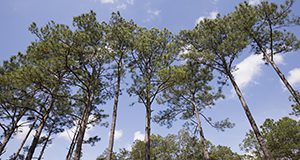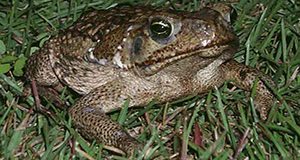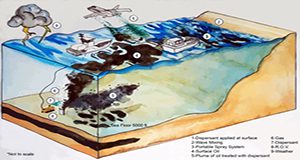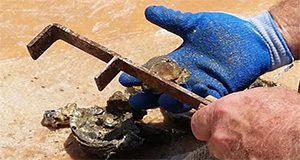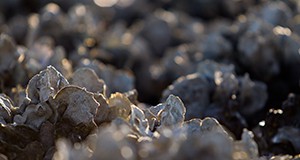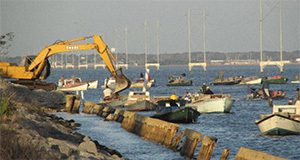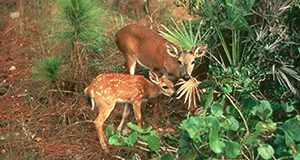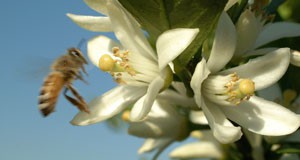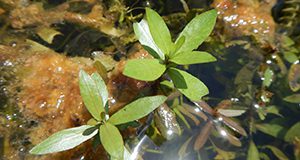The tricolored bat, formerly known as the eastern pipistrelle, is the smallest bat found in the state of Florida. It weighs just about as much as a nickel and a penny. Because of their small size and erratic flight pattern, tricolored bats are often mistaken for moths when seen in flight from a long distance away. You can learn to distinguish the tricolored bat from other bat species found in Florida with this three-page fact sheet written by Emily Evans, Terry Doonan, and Holly Ober and published by the UF/IFAS Department of Wildlife Ecology and Conservation.
http://edis.ifas.ufl.edu/uw434
Category: Ecosystems & Species
Florida's Bats: Evening Bat
The evening bat is a relatively small, forest-dwelling bat. Evening bats are dark brown to yellow with short brown ears and a broad, hairless muzzle. This species looks like the big brown bat but is noticeably smaller. Learn to distinguish evening bats from big brown bats and other common Florida species of bats in this three-page fact sheet written by Emily Evans, Terry Doonan, and Holly Ober and published by the UF/IFAS Department of Wildlife, Ecology and Conservation.
http://edis.ifas.ufl.edu/uw435
Florida Trees Store Carbon in Forests and Wood Products
Trees store carbon as they grow and produce wood. Carbon, and carbon storage in particular, have become important topics as policymakers, scientists, and industry leaders consider how to address the increasing amount of CO2 in our atmosphere. Because it changes the composition of the atmosphere, CO2 is a leading contributor to climate change. This 4-page fact sheet written by Adam Maggard, Leslie Boby, and Martha Monroe and published by the UF/IFAS School of Forest Resources and Conservation explains how storing carbon in living trees and in long-lasting wood products such as lumber and furniture can reduce atmospheric CO2. Florida’s forest and wood-product industries are worth billions of dollars. Clean water, wildlife, and other benefits add to the value and importance of these forests.
http://edis.ifas.ufl.edu/fr409
New Featured Creatures
Regenerated Sabal/Cabbage Palms (Sabal palmetto): Why and How
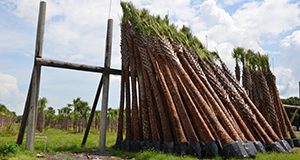 Palms are woody monocots characterized by the production of adventitious roots from the base of the trunk. Unlike the woody roots of dicots, such as oaks, gumbo limbo, and sea grapes, palm roots have no secondary thickening. Also, unlike trees, palms are incapable of repairing damage to their trunks. Most importantly, the life of a palm is dependent upon the continued good health of the single growing bud known as the meristem. Thus, if the palm bud is killed, the entire palm or the palm cane will eventually die. This 4-page fact sheet discusses harvesting and transplanting sabal palms, cropped transplants, and regenerated transplants. Written by Stephen H. Brown and Tim Broschat, and published by the UF/IFAS Environmental Horticulture Department, September 2017.
Palms are woody monocots characterized by the production of adventitious roots from the base of the trunk. Unlike the woody roots of dicots, such as oaks, gumbo limbo, and sea grapes, palm roots have no secondary thickening. Also, unlike trees, palms are incapable of repairing damage to their trunks. Most importantly, the life of a palm is dependent upon the continued good health of the single growing bud known as the meristem. Thus, if the palm bud is killed, the entire palm or the palm cane will eventually die. This 4-page fact sheet discusses harvesting and transplanting sabal palms, cropped transplants, and regenerated transplants. Written by Stephen H. Brown and Tim Broschat, and published by the UF/IFAS Environmental Horticulture Department, September 2017.
http://edis.ifas.ufl.edu/ep543
New and Revised Featured Creatures, September and October 2017
Founded in 1996, Featured Creatures provides in-depth profiles of insects, nematodes, arachnids and other organisms. Their website is a cooperative venture of the University of Florida’s Entomology and Nematology Department and the Florida Department of Agriculture and Consumer Services’ Division of Plant Industry. EDIS hosts copies of these profiles in fact sheet format. In September and October, the following have been added:
- Entomopathogenic Nematodes of Thrips Thripinema spp. (Nematoda: Tylenchida: Allantonematidae)
- Redbanded Stink Bug, Red-Banded Stink Bug, Smaller Green Stink Bug (suggested common names) Piezodorus guildinii (Westwood) (Insecta: Hemiptera: Pentatomidae)
- A Shoemaker Butterfly Prepona Laertes (Lepidoptera: Nymphalidae)
- Spiral Nematode Helicotylenchus spp. (Nematoda: Tylenchida: Hoplolaimidae)
The Cane or "Bufo" Toad (Rhinella marina) in Florida
Cane toads are an invasive species in Florida and in many countries around the world. They have been established in Florida since the 1950s. Cane toads are larger and more poisonous than Florida’s native toads; they can be fatal to dogs that try to eat them, and they may be harmful to Florida’s native species. Discover the history of cane toads in Florida and learn to distinguish them from native toads. Find out the impacts they can have on both ecosystems and people, and get tips on how to deal with them in yards and neighborhoods in this 6-page publication written by Steve Johnson and Audrey Wilson and published by the Wildlife Ecology and Conservation Department.
http://edis.ifas.ufl.edu/uw432
Oil Spill Science: Sea Grant Programs of the Gulf of Mexico: Persistence, Fate, and Effectiveness of Dispersants used During the Deepwater Horizon Oil Spill
This 9-page fact sheet concerns the use of dispersants in response to the Deepwater Horizon (DWH) oil spill, the first spill that occurred in the deep ocean, nearly a mile below the surface. The large-scale applications of dispersants used at the surface and wellhead during the Deepwater Horizon oil spill raised many questions about dispersants and highlighted the importance of understanding their effects on the marine environment. Written by Monica Wilson, Larissa Graham, Christine Hale, Emily Maung-Douglass, Stephen Sempier, and LaDon Swann and published by the Florida Sea Grant College Program, the fact sheet was selected for publication on EDIS by Monica Wilson. Originally published at the National Sea Grant Library: https://eos.ucs.uri.edu/EOS_Linked_Documents/gomsg/EX-GOMRI-1%20-%20Wilson_M_2015.pdf
http://edis.ifas.ufl.edu/sg150
Reducing Human-Bear Conflicts: Bear-Resistant Trash Cans
The Florida black bear (Ursus americanus floridanus) is the only species of bear in Florida, with an estimated population of approximately 4,030 bears. Bears that eat garbage put themselves in danger. This 3-page fact sheet written by Ethan T. Noel, Elizabeth F. Pienaar, and and Mike Orlando and published by the Wildlife Ecology and Conservation Department explains how to secure human garbage from bears so that they don’t become reliant on human food sources, a condition that puts them at great risk of being killed from vehicle collisions, illegal shooting, or euthanasia.
http://edis.ifas.ufl.edu/uw429
New Featured Creatures for April 2017
Plants and Youth: Designing and Building a Terrarium
A terrarium is a collection of small plants growing in a clear, usually enclosed, container. This three-page fact sheet walks you through the process of creating your own terrarium. Written by Amy Vu and Sydney Park Brown, and published by the Environmental Horticulture Department.
http://edis.ifas.ufl.edu/mg356
Securing Bird Feeders from Florida Black Bears
The Florida black bear (Ursus americanus floridanus) is the only species of bear in Florida, with an estimated population of approximately 4,030 bears. Bears are excellent climbers and can access bird feeders that are suspended from trees. This 3-page fact sheet written by Ethan T. Noel and Elizabeth F. Pienaar and published by the Wildlife Ecology and Conservation Department explains how to secure bird seed from bears so that they don’t become reliant on human food sources, a condition that puts them at greater risk of being killed from vehicle collisions, illegal shooting, or euthanasia.
http://edis.ifas.ufl.edu/uw430
Pesticide Labeling: Protection of Pollinators
On May 29, 2015, the EPA published its Proposal to Mitigate Exposure to Bees from Acutely Toxic Pesticide Products. This seven-page fact sheet outlines the highlights from this policy and its proposed restrictions, which would prohibit applications of pesticide products that are acutely toxic to bees during bloom where honey bees are known to be present under contract for pollination services. Written by Frederick M. Fishel, James Ellis, and Gene McAvoy and published by the Agronomy Department.
edis.ifas.ufl.edu/pi271
Oysters for the Future: Proper Oyster Culling Techniques Matter
The eastern oyster (Crassostrea virginica) provides many important functions in coastal environments, from serving a crucial role in the estuary’s food web to improving water quality for beachgoers and wildlife. Oysters are also a popular food choice for people. At times the commercial industry landings value has topped $8 million annually in Florida. This 2-page facts sheet written by Erik Lovestrand and published by the Florida Sea Grant College Program is one in a series that highlights some of the key ecological and human factors important to the long-term sustainability of this valuable fishery.
http://edis.ifas.ufl.edu/sg143
Oysters for the Future: Oystering Rules, The Whys and Wherefores
The eastern oyster (Crassostrea virginica) provides many important functions in coastal environments, from serving a crucial role in the estuary’s food web to improving water quality for beachgoers and wildlife. Oysters are also a popular food choice for people. At times the commercial industry landings value has topped $8 million annually in Florida. This 2-page fact sheet written by Erik Lovestrand and published by the Florida Sea Grant College Program is one in a series that highlights some of the key ecological and human factors important to the long-term sustainability of this valuable fishery.
http://edis.ifas.ufl.edu/sg144
Oysters for the Future: The Value of Science-Based Management in the Oyster Fishery
The eastern oyster (Crassostrea virginica) provides many important functions in coastal environments, from serving a crucial role in the estuary’s food web to improving water quality for beachgoers and wildlife. Oysters are also a popular food choice for people. At times the commercial industry landings value has topped $8 million annually in Florida. This 2-page fact sheet written by Erik Lovestrand and published by the Florida Sea Grant College Program is one in a series that highlights some of the key ecological and human factors important to the long-term sustainability of this valuable fishery.
http://edis.ifas.ufl.edu/sg145
Awareness, Knowledge, and Perceptions of Barotrauma and Barotrauma Mitigation: A Survey of Florida Anglers
Saltwater recreational fishing is an important economic engine for Florida’s coastal communities. The annual economic impact to the Florida economy of saltwater recreational fishing, which sustains 110,000 jobs, is estimated to be $13 billion. Given the popularity and economic importance of reef fish, careful management of these fish stocks is imperative for the sustainability of the reef-fish resource. Barotrauma, a phenomenon that causes problems for deep-water fish caught and brought to the surface, is recognized by fishery managers as a key cause of death in “catch-and-release” reef fish. This 5-page fact sheet written by Charles Adams, Joy Hazell, Lisa Krimsky, Bryan Fluech, Betty Staugler, John Stevely, and Robert Botta and published by Food and Resource Economics Department describes a recent survey of Florida saltwater anglers and sheds light on incentives for and constraints against the use of barotrauma mitigation devices.
http://edis.ifas.ufl.edu/fe1010
Climate Changes, Shifting Ranges: Climate change effects on wildlife in the Florida Everglades and Keys
Where do the animals go when the sea rises? Learn the probable futures of Florida panthers and other south Florida wildlife in this 5-page fact sheet. Written by Larry Perez, James I. Watling, David Bucklin, Mathieu Basille, Frank J. Mazzotti, Stephanie Romañach, and Laura Brandt and published by the UF Department of Wildlife Ecology and Conservation, it explains how a changing climate could impact wild animals.
edis.ifas.ufl.edu/uw428
Does Consumers' Awareness Impact Their Purchase Likelihood of Neonic-Free Plants?
Neonicotinoid (neonic) pesticides have been facing intense scrutiny because of their potential role in pollinator insect population declines. Research has shown that insecticide use in general has resulted in $284 million per year in damages to honeybee and pollinator services in the United States. This is especially worrying because food supply would fail to meet increasing global food demand without pollinator insects.
Consumer awareness of neonic pesticides increases the purchase likelihood for plants that are labeled “neonic-free,” and, as consumer awareness of neonics increases, demand for plants may decrease if there is limited availability of neonic-free options. This 5-page fact sheet written by Hayk Khachatryan and Alicia Rihn and published by the Food and Resource Economics Department explains the practical implications for growers, retailers, and policy makers and describes how these stakeholders can benefit from increased awareness of this important new market niche.
edis.ifas.ufl.edu/fe1008
East Indian Hygrophila: Hygrophila polysperma (Roxb.) T. Anderson
East Indian hygrophila is a submersed aquatic weed that has invaded a number of aquatic systems in the southeastern United States. It is a federally listed noxious weed and a Florida Class II prohibited plant. Established populations of East Indian hygrophila interfere with human uses of bodies of water and disrupt ecosystems by forming dense, impenetrable monocultures that clog the water column, restrict water flow, and create poor habitat for aquatic fauna. This 5-page fact sheet provides an overview of the plant and discusses its habitat and control. Written by Lyn A. Gettys and Stephen F. Enloe, and published by the UF Agronomy Department, December 2016.
http://edis.ifas.ufl.edu/ag413


